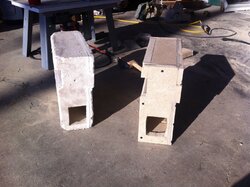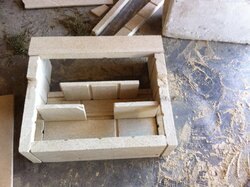I am toying with just cleaning out the junk cat scraps and refractory from my melted down VC Defiant Encore and running it as a non cat stove, and wondering how bad that would be. Would it just be the equivalent of a pre-EPA smoke dragon, like the original Vigilant (which had secondary combustion which didn't really work) and require a bit more attention to keeping the chimney clean, or would it be a real pig, inefficient or flithy? We heat a whole house with it, so it gets run pretty hard, which should help.
Burn a Cat stove without Cat, or what to do with VC Encore(2)
- Thread starter slindo
- Start date
-
Active since 1995, Hearth.com is THE place on the internet for free information and advice about wood stoves, pellet stoves and other energy saving equipment.
We strive to provide opinions, articles, discussions and history related to Hearth Products and in a more general sense, energy issues.
We promote the EFFICIENT, RESPONSIBLE, CLEAN and SAFE use of all fuels, whether renewable or fossil.
You are using an out of date browser. It may not display this or other websites correctly.
You should upgrade or use an alternative browser.
You should upgrade or use an alternative browser.
- Status
- Not open for further replies.
mellow
Resident Stove Connoisseur
I have family up north that got tired of dealing with the cat and run their old Englander with no cat (despite me offering to buy them a new one), they burn 2 cords more a winter now but they keep warm, from what they tell me they just have to burn it hot to "clean" the chimney more often now (would not recommend doing this either). It will be spewing all kinds of smoke and you can count on gallons of creosote.
I wouldn't recommend it but if you don't have money to rebuild that stove you gotta do what you gotta do, but I would buy a rebuild kit and burn it proper.
I wouldn't recommend it but if you don't have money to rebuild that stove you gotta do what you gotta do, but I would buy a rebuild kit and burn it proper.
corey21
Minister of Fire
You would need to clean that chimney a lot it sounds to me it would be a lot of trouble down the road.
BrowningBAR
Minister of Fire
I am toying with just cleaning out the junk cat scraps and refractory from my melted down VC Defiant Encore and running it as a non cat stove, and wondering how bad that would be. Would it just be the equivalent of a pre-EPA smoke dragon, like the original Vigilant (which had secondary combustion which didn't really work) and require a bit more attention to keeping the chimney clean, or would it be a real pig, inefficient or flithy? We heat a whole house with it, so it gets run pretty hard, which should help.
The efficiency would plummet and burn times would be short. It would be worse than a pre-epa stove and worse than a Vigilant, which I have run as well.
As I mentioned previously, it sounds like you would greatly benefit from a cat probe as you are most likely running the cat at extreme temps which caused the shortened lifespan of your cat and assembly.
BrowningBAR
Minister of Fire
jharkin
Minister of Fire
Agree with all of hte above. You would have two options:
Burn with the bypass open - in which case its going to draft like mad and probably burn pretty hot even with the air turned down.
Or you burn with the bypass closed to slow it in which case it will act like a stalled cat and you will smoke out the entire neighborhood.
In either case get ready to use a LOT of wood and clean that chimney VERY often.
Burn with the bypass open - in which case its going to draft like mad and probably burn pretty hot even with the air turned down.
Or you burn with the bypass closed to slow it in which case it will act like a stalled cat and you will smoke out the entire neighborhood.
In either case get ready to use a LOT of wood and clean that chimney VERY often.
Ashful
Minister of Fire
Burn with the bypass open - in which case its going to draft like mad and probably burn pretty hot even with the air turned down.
Or you burn with the bypass closed to slow it in which case it will act like a stalled cat and you will smoke out the entire neighborhood.
With no cat installed, why would the position of the bypass damper cause the two effects you describe above? I burn a Jotul cat stove, so maybe I'm missing something unique to the Encore, but mine burns in a very controlled manner with the bypass damper open. I've never had trouble with it drafting like mad.
Likewise, although I haven't tried it, I don't see why it would stall when I close the bypass damper, if no cat was installed.
mellow
Resident Stove Connoisseur
Both ways burn hot and fast in my experience. The bypass being open would just triple the amount of area for smoke to go out, hence it burning hotter. No real way to turn it down to smolder unless it is air tight.
The funny thing is, for some idefinite length of time last spring after the stove melted down we were running it with a totally trashed cat and didn't even notice - sure the smoke coming out the chimney was a little darker than I'd prefer, but that usually just means time to clean the cat, which I often leave off doing until the beginning of the heating season rather than the end. So a lot of the more dire predictions did not happen - it still ran overnight without problems, maybe burnt a bit more wood but no so much as we noticed, and gallons of creasote were not dribbling down onto the floor like with an old Shenandoah.
BTW my reason for not fixing it correctly is not that I don't have the money, but just that I am not willing to throw any more money at it. Its a lovely stove at best, but finicky about wood, and increasingly likely as it ages (or as the quality of replacement parts deteriorates) to self-destruct.
Yeah, I could but a probe in but its a bit late now. And I really hat the idea of sticking cheap add-on electronic temp gauges on a 500lb iron wood stove.
BTW my reason for not fixing it correctly is not that I don't have the money, but just that I am not willing to throw any more money at it. Its a lovely stove at best, but finicky about wood, and increasingly likely as it ages (or as the quality of replacement parts deteriorates) to self-destruct.
Yeah, I could but a probe in but its a bit late now. And I really hat the idea of sticking cheap add-on electronic temp gauges on a 500lb iron wood stove.
BrowningBAR
Minister of Fire
The funny thing is, for some idefinite length of time last spring after the stove melted down we were running it with a totally trashed cat and didn't even notice - sure the smoke coming out the chimney was a little darker than I'd prefer, but that usually just means time to clean the cat, which I often leave off doing until the beginning of the heating season rather than the end. So a lot of the more dire predictions did not happen - it still ran overnight without problems, maybe burnt a bit more wood but no so much as we noticed, and gallons of creasote were not dribbling down onto the floor like with an old Shenandoah.
BTW my reason for not fixing it correctly is not that I don't have the money, but just that I am not willing to throw any more money at it. Its a lovely stove at best, but finicky about wood, and increasingly likely as it ages (or as the quality of replacement parts deteriorates) to self-destruct.
Yeah, I could but a probe in but its a bit late now. And I really hat the idea of sticking cheap add-on electronic temp gauges on a 500lb iron wood stove.
You have an odd idea of what a cat probe is. It prevents you from destroying $500 worth of parts. Are you using a stove thermometer on your stove at all to judge how hot you are running the stove?
Also, part of your post indicates you are using wet wood ("finicky about wood").
If I were you I would get my wood supply in order, because all modern stoves do not run well on poor fuel, and either fix the stove so it runs properly and safely, or buy a new stove.
I did look at cat probes a few years ago. To read the Condar one I would have had to get down on my knees with a flashlight and a mirror. I've always found that the harder a gauge is to read, the less use it is. The guy at the store tried to sell me a remote, digital one, hence my comments about electronic gadgets. Though you are or course right, . in retrospect I should have bought the damn thing.
Oh, when we first started using the Encore, 23 years ago we used some pretty lousy wood, but after the first rebuild cleaned up our act - thought I can't help but suspect too-dry wood was a factor in the final meltdown.
We probably will get a new stove eventually - an Oslo seems inevitable - but I really would like to find a use for our lovely, still solid, "iron" stove but will be damned if I will pay VC's extortionate prices to do so.
Oh, when we first started using the Encore, 23 years ago we used some pretty lousy wood, but after the first rebuild cleaned up our act - thought I can't help but suspect too-dry wood was a factor in the final meltdown.
We probably will get a new stove eventually - an Oslo seems inevitable - but I really would like to find a use for our lovely, still solid, "iron" stove but will be damned if I will pay VC's extortionate prices to do so.
You have an odd idea of what a cat probe is. It prevents you from destroying $500 worth of parts. Are you using a stove thermometer on your stove at all to judge how hot you are running the stove?
Also, part of your post indicates you are using wet wood ("finicky about wood").
If I were you I would get my wood supply in order, because all modern stoves do not run well on poor fuel, and either fix the stove so it runs properly and safely, or buy a new stove.
Backwoods Savage
Minister of Fire
I did look at cat probes a few years ago. To read the Condar one I would have had to get down on my knees with a flashlight and a mirror. I've always found that the harder a gauge is to read, the less use it is. The guy at the store tried to sell me a remote, digital one, hence my comments about electronic gadgets. Though you are or course right, . in retrospect I should have bought the damn thing.
Oh, when we first started using the Encore, 23 years ago we used some pretty lousy wood, but after the first rebuild cleaned up our act - thought I can't help but suspect too-dry wood was a factor in the final meltdown.
We probably will get a new stove eventually - an Oslo seems inevitable - but I really would like to find a use for our lovely, still solid, "iron" stove but will be damned if I will pay VC's extortionate prices to do so.
Don't mean to rain on your parade but I don't see how too-dry wood would do this simply because I've never seen too dry wood. We regularly burn wood that has been split and stacked for 6-7 years and sometimes more. In addition, the majority of the wood we've burned the past 10 years has been dry when we cut it (dead from EAB).
I know every once in a while we hear this but, I do not ever expect to see too dry wood. Most of that too dry wood talk comes from the old-time wood burners and they claim if you put dry wood in the stove, puff, and it is gone. Not so and especially with today's stoves. Today's stoves love that dry wood.
jharkin
Minister of Fire
With no cat installed, why would the position of the bypass damper cause the two effects you describe above? I burn a Jotul cat stove, so maybe I'm missing something unique to the Encore, but mine burns in a very controlled manner with the bypass damper open. I've never had trouble with it drafting like mad.
Likewise, although I haven't tried it, I don't see why it would stall when I close the bypass damper, if no cat was installed.
The encore is a downdraft cat stove. With the bypass closed the smoke has to follow a more convoluted path through very small openings and two 180 turns to exit. Open its a straight shot into the full size flue. Very little flow restriction.
firefighterjake
Minister of Fire
Honestly . . . I think I would do what you no doubt have already thought about . . . sell the VC and buy a Jotul . . . and not look back.
As long as you let the future owner know that it is being sold as is and you have a fair price on it I would say you could sleep well at night . . . and be much happier in the long run.
As long as you let the future owner know that it is being sold as is and you have a fair price on it I would say you could sleep well at night . . . and be much happier in the long run.
Just ran into this, in the manual for the Encore 2-in-1:
"Avoid using a full load of very dry wood in the firebook. This may result in continuous very high temperatures in the secondary combustion and damage the combustor. If you must burn extra dry wood , mix it with greener wood for a longer fire and less stress on the combustor."
"Avoid using a full load of very dry wood in the firebook. This may result in continuous very high temperatures in the secondary combustion and damage the combustor. If you must burn extra dry wood , mix it with greener wood for a longer fire and less stress on the combustor."
Don't mean to rain on your parade but I don't see how too-dry wood would do this simply because I've never seen too dry wood.
Backwoods Savage
Minister of Fire
Slindo, you have to remember that even some manufacturers still get their information out of old books. Cut and paste works fine for many. I still would not be convinced. However, if you are talking about super dry pine, cut wood from pallets and even a full load of kindling, then it definitely could be a problem. However, I would hope there would not be that many ignorant people who would do such a thing. Still.....
All in all, one still has to use some common sense. If one does not have that common sense about wood burning, then they need to find answers....but be careful about some answers you might get ! I've talked to a lot of folks who have some very strange beliefs when it comes to wood burning.
! I've talked to a lot of folks who have some very strange beliefs when it comes to wood burning.
All in all, one still has to use some common sense. If one does not have that common sense about wood burning, then they need to find answers....but be careful about some answers you might get
 ! I've talked to a lot of folks who have some very strange beliefs when it comes to wood burning.
! I've talked to a lot of folks who have some very strange beliefs when it comes to wood burning.
P
Pallet Pete
Guest
Don't mean to rain on your parade but I don't see how too-dry wood would do this simply because I've never seen too dry wood. We regularly burn wood that has been split and stacked for 6-7 years and sometimes more. In addition, the majority of the wood we've burned the past 10 years has been dry when we cut it (dead from EAB).
I know every once in a while we hear this but, I do not ever expect to see too dry wood. Most of that too dry wood talk comes from the old-time wood burners and they claim if you put dry wood in the stove, puff, and it is gone. Not so and especially with today's stoves. Today's stoves love that dry wood.
To add to that we have discovered that stove dealers love to throw the to dry wood out immediately ! ( Check your supply its to dry thats the problem ) Its a reason for them not to look. I have to agree with Dennis on this the wood unless kiln dried is not likely to be to dry. It sounds like its just running to hot on the cat. There are a few people I know who have this issue and so far the fix has been simply larger splits. If the split is too small the stove will burn very hot compared to larger splits which gives you more control over the stove.
Pete
BrowningBAR
Minister of Fire
Just ran into this, in the manual for the Encore 2-in-1:
"Avoid using a full load of very dry wood in the firebook. This may result in continuous very high temperatures in the secondary combustion and damage the combustor. If you must burn extra dry wood , mix it with greener wood for a longer fire and less stress on the combustor."
VC has had that info in their manuals for nearly three decades. It is worthless information unless you are burning pallets.
I have been burning the stove minus the cat for a week now while I mull over what to replace it with, and am surprised how normally it seems to be working. Cleaner, indeed, than I can recall the old smoke dragon Vigilant ever was.
I was looking over the old VC literature on the stove, wondering if there would be some way to add air tubes to it , and it dawned on me that the stove, just as it is, has all the elements of a secondary combustion system. The Encore was one of the few cat stoves of its era that provided thermostatically regulated, preheated combustion air directly to the cat rather than relying on whatever oxygen was left in the primary combustion air. This air entered in the back, then went up the front of the refractory box in a thin sheet sandwiched between the fireback and a stainless steel sheet VC called the Heat Exchanger. Apart from the air being delivered in a sheet rather than in many little jets there is very little difference between the layout in our Encore without the cat, and a modern no-cat EPA stove with air tubes or other means of providing air to induce secondary combustion.
So is secondary combustion really happening? The usual way to confirm it to look for the telltale wispy flames, but with the Encore, if there is secondary combustion it is occuring out of sight. in the refractory box. I am toying with putting a pyrex porthole in the cat cover just to see what going on inside.
It would be interesting to know if VC ever tested the first generator cat stoves without the cats, and if so how well they did on emissions.
Ashful
Minister of Fire
The Encore was one of the few cat stoves of its era that provided thermostatically regulated, preheated combustion air directly to the cat rather than relying on whatever oxygen was left in the primary combustion air... So is secondary combustion really happening? The usual way to confirm it to look for the telltale wispy flames, but with the Encore, if there is secondary combustion it is occuring out of sight. in the refractory box. I am toying with putting a pyrex porthole in the cat cover just to see what going on inside.
Sounds like a lot of work to avoid just replacing a cat. That said, which cat stoves relied on leftover oxygen from the primary combustion air for secondary combustion? I only have experience with Jotul 12's, and they definitely supply fresh air to the cat chamber. I had assumed all stoves did.
Secondary combustion will occur without a catalyst at some temperature, although it will always be a much higher temperature than without. Also, don't forget the catalyst is usually providing some structure to direct and accellerate air flow thru it.
Calentarse
Feeling the Heat
I see where people are giving you a hard time for your argument of "too dry" wood for excessive griddle temps and subsequent fireback deterioration. I tend to agree with you. If I were to load my stove with all real dry oak on a bed of coals look out... that thing would be nuclear. One thing I've learned is that if you mix a little bit of green wood with your dry it helps keep those temps down. Obviously not an ideal situation for your chimney etc. but a solution nevertheless.I did look at cat probes a few years ago. To read the Condar one I would have had to get down on my knees with a flashlight and a mirror. I've always found that the harder a gauge is to read, the less use it is. The guy at the store tried to sell me a remote, digital one, hence my comments about electronic gadgets. Though you are or course right, . in retrospect I should have bought the damn thing.
Oh, when we first started using the Encore, 23 years ago we used some pretty lousy wood, but after the first rebuild cleaned up our act - thought I can't help but suspect too-dry wood was a factor in the final meltdown.
We probably will get a new stove eventually - an Oslo seems inevitable - but I really would like to find a use for our lovely, still solid, "iron" stove but will be damned if I will pay VC's extortionate prices to do so.
If you've followed my experience on the forum, you'll find that I have trouble keeping my temperatures in check as well. Personally, I don't see where a temperature gauge on the combustor would make much difference either! What will I do if I see that it's hot enough to cause damage? Reach in and grab a piece and throw it out in the driveway? Do some real damage and dump some water in there lol. The air controls I have access to will have already been closed down for quite some time so knowing what's going on back there will only make me cry a little more over this machine with a mind of its own.
jharkin
Minister of Fire
Personally, I don't see where a temperature gauge on the combustor would make much difference either! What will I do if I see that it's hot enough to cause damage?
Open up the bypass and dump heat up the flue while the cat cools back down to safe temps. This generally takes less then 10minutes then you can reengage and often the stove settles down. Not risky at all and a much better option than ruining a $200 catalyst or warping iron.
BTW, seems like we are digging up a lot of old dead threads today?
Calentarse
Feeling the Heat
LOL, yes. Only recently found all these threads and they're so interesting leaving me with even more questions. Sorry for bringing back the dead hahaha.
My stove does seem to self-regulate and doesn't stay at 700+ degree temps very long. I had always just left the catalyst engaged and obviously wood can only fuel those kinds of numbers for a short while.
I have a strip of single wall pipe 6 ft. long above the stove; I wouldn't want to open my damper to send all that heat up into that pipe. That would scare me. I'd rather torch the catalyst than burn my house down. Either way, not a good scenario. LOL, typing this reminds me of a quote earlier in a thread I read. "Don't like having to do the same song and dance to get it to work properly." HAHAHA
My stove does seem to self-regulate and doesn't stay at 700+ degree temps very long. I had always just left the catalyst engaged and obviously wood can only fuel those kinds of numbers for a short while.
I have a strip of single wall pipe 6 ft. long above the stove; I wouldn't want to open my damper to send all that heat up into that pipe. That would scare me. I'd rather torch the catalyst than burn my house down. Either way, not a good scenario. LOL, typing this reminds me of a quote earlier in a thread I read. "Don't like having to do the same song and dance to get it to work properly." HAHAHA
Excavator
Feeling the Heat
I elected to buy the complete kit to rebuild the refractory and fireback. It was expensive but I have no regrets in rebuilding my 1989 Defiant Encore. I get all my firewood from my jobs clearing land for new homes so the cost of the fireback kit was absorbed no problem
http://www.woodmanspartsplus.com/557669/products/Vermont-Castings-Defiant-Encore-Fireback-Kit.html
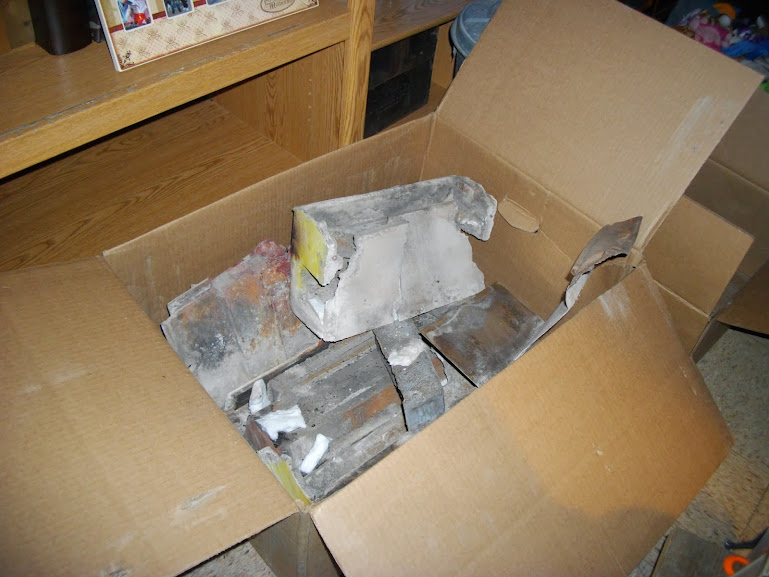
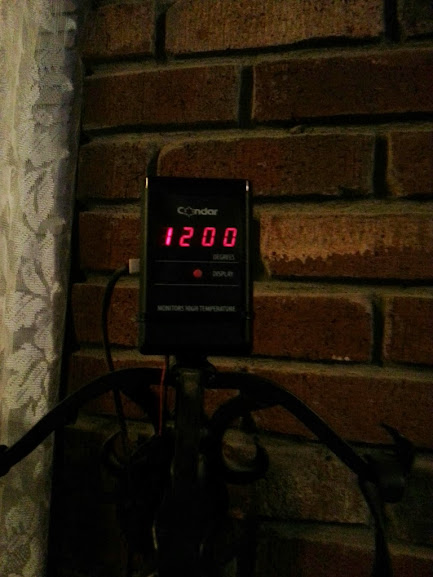
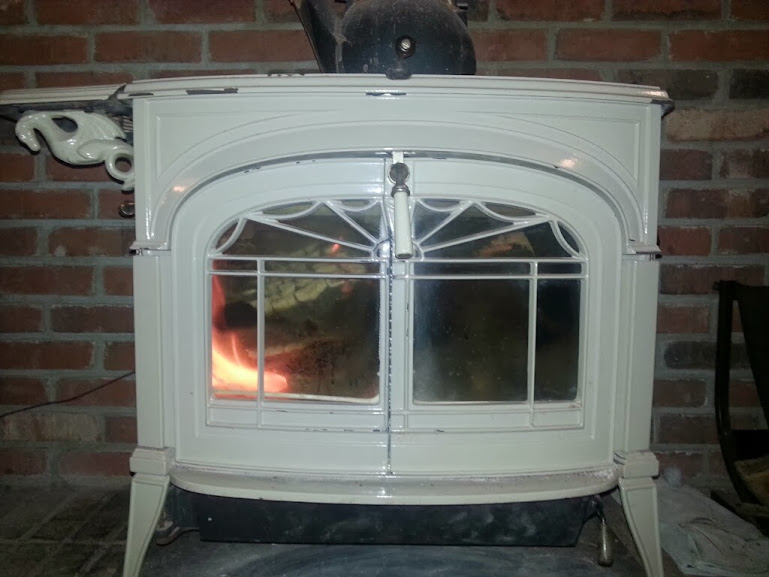
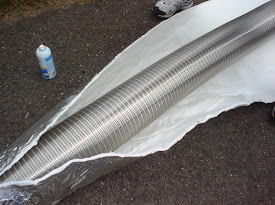
http://www.woodmanspartsplus.com/557669/products/Vermont-Castings-Defiant-Encore-Fireback-Kit.html
Last edited:
I've been tinkering around with an old defiant encore. I made my own combustion box out of Skamol. The same stuff Jotul uses for the baffle in the Oslo. It has been doing fine, I made a cat and a non-cat box. The second pic is of the non-cat without the back on it yet.
Attachments
- Status
- Not open for further replies.
Similar threads
- Replies
- 1
- Views
- 778
- Replies
- 8
- Views
- 1K
- Replies
- 39
- Views
- 6K
- Replies
- 11
- Views
- 2K


